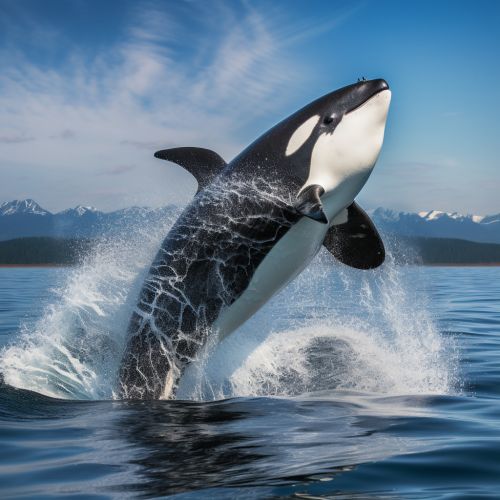Killer whale
Taxonomy and Evolution
The killer whale, or Orcinus orca, is the largest member of the oceanic dolphin family, known as Delphinidae. The species is part of the order Cetacea, which includes whales, dolphins, and porpoises. The genus name Orcinus means "of the kingdom of the dead," referring to the species' top predator status.


The evolutionary history of the killer whale is still under scientific debate. Some researchers propose that the killer whale diverged from other dolphins around 5 million years ago during the Miocene epoch. However, others suggest a more recent divergence, possibly during the Pleistocene epoch, less than 1 million years ago.
Physical Characteristics
Killer whales are easily recognizable by their distinctive black-and-white coloration. Adult males typically measure 6 to 8 meters in length and can weigh up to 6 tons. Females are slightly smaller, usually measuring 5 to 7 meters and weighing up to 4 tons. The largest recorded killer whale was a male measuring 9.8 meters long.
One of the most distinctive features of the killer whale is its tall dorsal fin. In males, the dorsal fin can reach a height of up to 1.8 meters, while in females and juveniles, it is significantly smaller and more curved.
Killer whales have a robust, streamlined body adapted for fast swimming. They can reach speeds of up to 56 km/h, making them one of the fastest marine mammals. They also have a large brain, with an average weight of 5.6 kg, which is among the largest of any marine mammal.
Behavior and Ecology
Killer whales are highly social animals, living in groups called pods. Pod size can vary greatly, ranging from two to over 50 individuals. These pods are usually matrilineal, meaning they are composed of a female, her offspring, and her female descendants.
Killer whales exhibit a variety of behaviors, including breaching, spy-hopping, and tail-slapping. These behaviors are believed to serve various purposes, such as communication, hunting, and play.
Killer whales are apex predators, meaning they are at the top of the food chain. They have a diverse diet, feeding on fish, squid, and marine mammals. Some populations specialize in hunting specific prey, such as seals, sea lions, or even other whales.
Distribution and Habitat
Killer whales are found in all oceans and most seas, from the frigid Arctic and Antarctic regions to tropical seas. They are most commonly found in coastal waters, but they can also be found in the open ocean.
Killer whales are highly adaptable and can thrive in a wide range of marine environments. They are known to inhabit both deep oceanic waters and shallow coastal waters. They can also be found in both cold and warm waters, from the polar ice caps to the equator.
Conservation Status
The conservation status of killer whales is complex due to the species' global distribution and the existence of distinct populations with varying statuses. The International Union for Conservation of Nature (IUCN) currently lists the killer whale as Data Deficient, meaning there is insufficient information to assess its risk of extinction.
However, some populations of killer whales are known to be at risk. For example, the Southern Resident killer whales in the northeastern Pacific Ocean are listed as Endangered under the U.S. Endangered Species Act.
